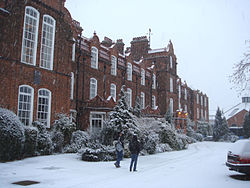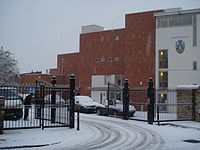Hughes Hall, Cambridge
| Hughes Hall
| |||||||||||||||
| Cambridgeshire | |||||||||||||||
|---|---|---|---|---|---|---|---|---|---|---|---|---|---|---|---|
|
Disce ut Servias | |||||||||||||||
 Margaret Wileman Building, Hughes Hall | |||||||||||||||
 | |||||||||||||||
| President: | Laurie Bristow | ||||||||||||||
| Website: | hughes.cam.ac.uk | ||||||||||||||
| |||||||||||||||
| Location | |||||||||||||||
| Grid reference: | TL45835799 | ||||||||||||||
| Location: | 52°12’3"N, -0°7’57"E | ||||||||||||||
Hughes Hall is a constituent college of the University of Cambridge in Cambridgeshire. It is the oldest of the University of Cambridge's postgraduate colleges. The college also admits undergraduates, though undergraduates admitted by the college must be aged 21 or over. There is no age requirement for postgraduate students. The majority of Hughes Hall students are postgraduate, although nearly one-fifth of the student population comprises individuals aged 21 and above who are studying undergraduate degree courses at the university.
Hughes Hall was founded in the 19th century as the Cambridge Training College for Women with the purpose of providing a college of the university dedicated to training women graduates for the teaching profession. Since then it has enlarged and expanded to support a community of students and researchers, both male and female, working in all the academic domains encompassed by the University of Cambridge.
The college is housed in a number of 19th- and 20th-century buildings at a main site adjacent to Fenner's, the Cambridge University Cricket Club ground, and between the City Centre and the railway station.
History
In 1878 the University of Cambridge established a Teachers' Training Syndicate to develop a training curriculum in education for students of the university intending to become teachers. Hughes Hall was established in 1885 as a college for women graduate students taking the Teacher Training curriculum. Key amongst its early supporters and founders were Rev. G. F. Browne, fellow of St Catharine's College, Miss Frances Buss, headmistress of the North London Collegiate School, Miss Anne Clough, first principal of Newnham College, and Professor James Ward, fellow of Trinity College.[1]

The college was founded as the Cambridge Training College for Women, and it began with 14 students in a small house in Newnham called Crofton Cottage. The first principal was a graduate of Newnham College, Elizabeth Phillips Hughes (1851-1925), who was in post from 1885 to 1899. In 1895, the college moved to a purpose-built building, designed by architect William Fawcett, overlooking Fenner's cricket ground - which continues to be the main college building to this day. One of the first matriculants, Molly Thomas, recounted the experience of the first class of students in A London Girl of the 1880s, published under her married name, M.V. Hughes.
Following recognition of full membership of the university for women in 1947, the college became a recognized institution of the university in 1949 and was renamed Hughes Hall in honour of its first principal. The college became an approved foundation of the university in 1985, and received a royal charter marking its full college status in 2006.[2]
The college's first male students arrived in 1973, making Hughes Hall the first of the all-female colleges to admit men, and from that time students began to study a wider range of affiliated post-graduate degrees.[3] Student numbers gradually increased in the 1980s and 1990s. Today, Hughes Hall has about 500 graduate students and around 90 undergraduates, all students are "mature" (aged over 21), and the college accommodates study in the wide range of studies taught in the university. The college is one of the most international Cambridge colleges, with its students representing over 60 nationalities.
College site
Buildings

The college's main building, known as the Wileman Building, was designed by architect William Fawcett and built in 1895. It was opened by Liberal politician George Robinson, 1st Marquess of Ripon.[4] The building is Grade II listed,[5] red brick in Neo-Dutch style, and has a notable terracotta porch.[6] One wing of the Wileman Building is named the Pfeiffer Wing, after husband and wife Jurgen Edward Pfeiffer and Emily Jane Pfeiffer who funded much of the construction cost as part of their mission to support and develop women's education. The building, and its more modern wings, contains student rooms, the college library, social areas and study spaces, and various college administrative offices.[7] Next door to the Wileman Building is Wollaston Lodge, a symmetrical early-20th-century building in buff brick, designed by Edward Schroeder Prior,[8] that provides further student accommodation.
Location
The main college site is near the middle of Cambridge, halfway between Cambridge railway station and the Market Square. The college is located in the Petersfield area of the city, close to Mill Road and accessible from Mortimer Road. The main site is in a mainly residential area, and it is beside the Fenner's cricket ground, and across the road from Parkside Pools and Kelsey Kerridge Gym, which are the main public sports facilities in the city. A short walk from the college is the Mill Road Cemetery where a number of the university's renowned historic figures, including astronomer James Challis, Isaac Newton's editor Percival Frost, and historian John Seeley are buried.
Outside links
| ("Wikimedia Commons" has material about Hughes Hall, Cambridge) |
References
- ↑ Martin, Ged (2011). Hughes Hall Cambridge 1885-2010. London: Third Millennium Publishing Limited and Hughes Hall. ISBN 978-1-906507-77-0.
- ↑ "Hughes Hall achieves full college status". Varsity Online. http://www.varsity.co.uk/news/418.
- ↑ Martin, Ged (2011). Hughes Hall Cambridge 1885-2010. London: Third Millennium Publishing Limited and Hughes Hall. p. 146. ISBN 978-1-906507-77-0.
- ↑ Kamm, Josephine (2012). How Different From Us: A Biography of Miss Buss and Miss Beale. Abingdon: Routledge.
- ↑ National Heritage List 1126027: Hughes Hall (Grade II listing)
- ↑ Mill Road Conservation Appraisal. Cambridge City Council. June 2011. p. 22. https://www.cambridge.gov.uk/sites/default/files/docs/mill-road-area-appraisal.pdf. Retrieved 13 June 2015.
- ↑ "Hughes Hall - History of Hughes Hall". https://www.hughes.cam.ac.uk/about-us/history-of-hughes-hall/.
- ↑ Mill Road Area Conservation Area Appraisal. Cambridge City Council. June 2011. p. 27. https://www.cambridge.gov.uk/sites/default/files/docs/mill-road-area-appraisal.pdf. Retrieved 13 June 2015.
- Margaret Bottrall, Hughes Hall 1885-1985 (Cambridge, 1985).
- M.V. Hughes, A London Girl of the 1880s (Oxford, 1936).
- Ged Martin, Hughes Hall Cambridge 1885-2010 (Third Millennium Publishing, 2011).
| Colleges of the University of Cambridge | |
|---|---|
|
Christ’s • Churchill • Clare • Clare Hall • Corpus Christi • Darwin • Downing • Emmanuel • Fitzwilliam • Girton • Gonville and Caius • Homerton • Hughes Hall • Jesus • King’s • Lucy Cavendish • Magdalene • Murray Edwards • Newnham • Pembroke • Peterhouse • Queens’ • Robinson • St Catharine’s • St Edmund’s • St John’s • Selwyn • Sidney Sussex • Trinity • Trinity Hall • Wolfson |
 |
